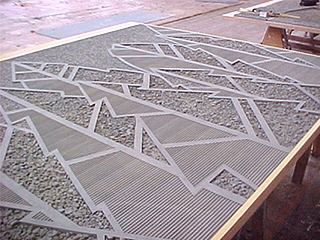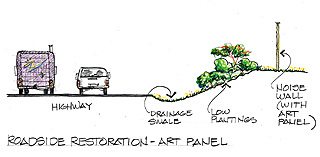
Surveys
DJC.COM
April 5, 2007
Making freeways more than just pavement
Osborn Pacific Group

Artists designed the noise walls that were installed along a section of I-5 in Everett. |
The I-5 Everett, SR 526 to US 2 HOV Lanes project is under construction. To complete this project on a fast track, the Washington State Department of Transportation (WSDOT) awarded a $185 million design-build contract to add HOV lanes on Interstate 5 through Everett 6 miles northbound and 4.5 miles southbound. This project will be completed in June 2008, which will be 2.5 years from the first preliminary designs to the last phase of installing landscape features.
In design-build, the experience of the landscape contractor (Terra Dynamics), the desires of the client (WSDOT) and the negotiation skills of the landscape architect (Osborn Pacific Group) work together to make the most of every public dollar spent on aesthetic treatment of the highway.
Roadside restoration
Restoration design along an interstate freeway is quite intense. The goal is to successfully integrate operational, environmental and visual functions by introducing long-term sustainable landscaping and aesthetic treatment. Within the Everett corridor, only the matter of safety surpassed roadside treatment to establish buffers by enclosing or screening views of the highway, by exposing distant views of the Cascade mountain range and by blending roadside elements into community enhancement areas.
From line-of-sight considerations to introduced obstructions, every tree and shrub is placed where it will do no harm. All new vegetation is planted to preserve and restore the roadside character and at the same time, pose no safety hazard. While one objective is to preserve vegetation wherever possible, some loss is unavoidable because the widened freeway requires clearing to maintain sight distance and safety.
Along the corridor, the landscape architect strives to improve visual quality, including positive driver guidance and navigation, distraction screening, corridor continuity and scenic view preservation. It is important to design informal, slightly irregular vegetative masses in scale with the viewing speed and to select native species to emulate surrounding vegetation. New native trees and shrubs are numerous in quantity and tiny in size because they establish quickly, pose less of a maintenance factor and are less costly.
Plain grass or wildflowers?

Images courtesy of Osborn Pacific Group Long-term sustainable landscaping is being used along with aesthetic treatments on the freeway. |
WSDOT has had some interesting and unexpected responses to wildflowers introduced along freeway corridors. The agency, with safety dictating design, is not interested in a repeat of creating spectacular poppy displays that inspired people to pose small children on gaily floral hillsides for photos to send to grandma. However, WSDOT developed a custom blend of erosion control seed mix containing wildflowers for use on the Everett HOV project. The selected seeds are readily available, so the public is not paying a premium for the mix. Because the flower seed composition represents sturdy, persistent species, the design-build team speculates that there should be seasonal color on the slopes for many years to come.
A sense of arrival
Creating a sense of arrival at each city exit was important to Everett officials. Early on, the city sought roadside treatments to reflect community character and to incorporate ornamental plantings that blend with and complement each neighborhood landscape character. It also wanted to include trees that integrate with the city street tree program.
Realization of these treatments was severely limited by space constraints at each city entrance. The roadside restoration areas at the on- and off-ramps were reduced to small, narrow planting zones. In place of planting, the city expressed an interest on expanding on its historical light fixtures to create a sense of entry. At selected community enhancement areas, WSDOT is replacing the ubiquitous cobra-head streetlights with historic-appearing standards identical to those seen throughout downtown Everett. Matching wall-mounted fixtures were paired at the corners of newly remodeled bridge abutments to complete the theme. While subtle, this permanent design element at the exits hints at the historic downtown beyond.
Wall artwork
Another opportunity to establish an identity for the city of Everett along the freeway corridor comes in the form of wall art. The city selected an artist to develop concepts for three themes: earth, water and sky. The design was analyzed and laid out so that all of a theme’s elements could be repeated on very few panels, thus saving liner costs. Such factors as end-pier design and detailing panel sequences to accommodate grade changes and wall heights were examined and detailed to ensure the continuity of the design when viewed at highway speeds.
The noise and retaining walls were the first aesthetic improvements to be installed. Early in the design process, it became apparent that another cost-saving opportunity existed — preserving trees, especially large conifers. Since the most beautiful stands of conifers seemed to grow next to future noise wall locations, the contractor brought in the largest booms possible to lift the panels up and over the treetops. This kind of sensitivity is a direct result of the design-build process and is just one example of the “across-the-table design” that results when a lot of cool heads sit down to talk.
Handling stormwater
Is stormwater treatment disguised as public access or is public access disguised as stormwater treatment?
There is a LOT of stormwater runoff from eight miles of freeway — about 3 million gallons each year. Bio-retention swales and sand filters collect and cleanse stormwater runoff throughout the freeway corridor. Some of this water flows into water quality treatment sites.
The largest water quality treatment feature on the project doubles as a public access site. Located in an area popular with Lowell neighborhood dog walkers and pedestrians, a series of connected stormwater wetlands will slow down and cleanse the stormwater as it proceeds to the river. The concept includes a path constructed on top of the berms that encompass the water quality treatment wetlands. The sides of the berms will be vegetated with native trees and shrubs that are spaced and mixed to provide a variety of views to features within the site and out to the Snohomish River. A bridge spans open water and wetlands and provides eventual access to the Lowell Riverfront Trail.
A new pedestrian bridge over the railroad tracks is a disguise. Yes, it will carry pedestrians from the Lowell neighborhood to the trail, but more importantly it will convey the roughly 3 million gallons of water through a suspended pipeline beneath the bridge deck. The views of the river from the bridge will be spectacular, but the stairway down will have its own surprise. At the east end of the bridge, stormwater will cascade over a series of baffles and levels and spill into a constructed rock pool to eventually flow into the wetlands and out to the river.
Interpretive signs at the pedestrian bridge and at the entrance to the water quality treatment site from Riverfront Trail were designed by Osborn Pacific Group and explain how these specially designed stormwater wetlands cleanse runoff prior to reaching the Snohomish River.
Stacy Winnick is a senior landscape architect at Osborn Pacific Group. She is the Landscaping & Aesthetics task leader for the I-5 Everett, SR 526 to US 2 HOV Lanes project, as well as the project manager for the I-5 South Everett Freeway Station project. Linda Osborn is founder and principal of Osborn Pacific Group.
Other Stories:
- Celebrate National Landscape Architecture Month
- Add value to your team with a landscape architect
- Designing playgrounds for the next generation
- UW team transforms garbage into gardens
- Park design gets a boost from street skaters
- How landscaping is greening up Seattle
Copyright ©2009 Seattle Daily Journal and DJC.COM.
Comments? Questions? Contact us.